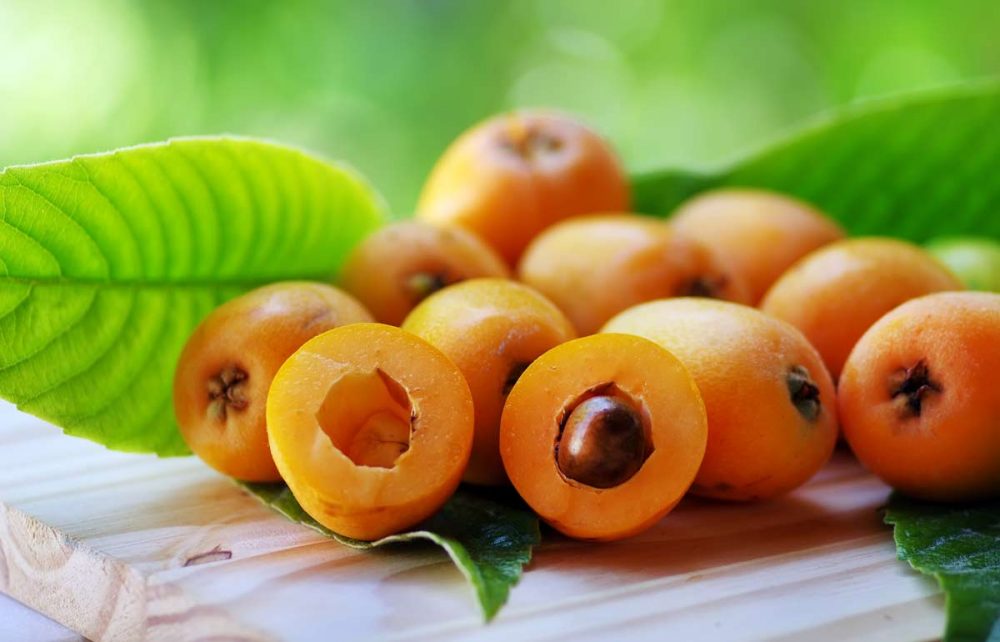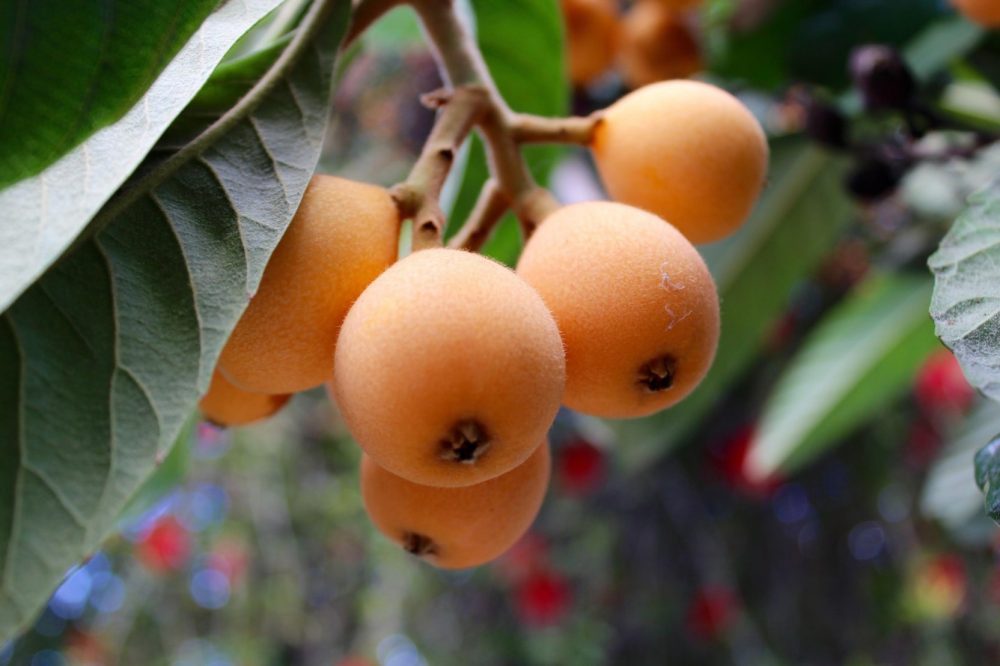
The loquat is a species of flowering plant in the family Rosaceae, native to south-central China. It is a large evergreen shrub or small tree, grown commercially for its yellow fruit, and also cultivated as an ornamental plant.
Eriobotrya japonica was formerly thought to be closely related to the genus Mespilus, and is still sometimes known as the Japanese medlar. It is also known as Japanese plumand Chinese plum. In Japan it is called biwa. And in China, it is called Lo Guat in Cantonese and pipa in Mandarin. In Turkey it is known as malta eriği, meaning Maltese plum.
Eriobotrya japonica is a large evergreen shrub or small tree, with a rounded crown, short trunk and woolly new twigs. The tree can grow to 5–10 metres (16–33 ft) tall, but is often smaller, about 3–4 metres (10–13 ft). The leaves are alternate, simple, 10–25 centimetres (4–10 in) long, dark green, tough and leathery in texture, with a serrated margin, and densely velvety-hairy below with thick yellow-brown pubescence; the young leaves are also densely pubescent above, but this soon rubs off.
Loquats are unusual among fruit trees in that the flowers appear in the autumn or early winter, and the fruits are ripe in late winter or early spring. The flowers are 2 cm (1 in) in diameter, white, with five petals, and produced in stiff panicles of three to ten flowers. The flowers have a sweet, heady aroma that can be smelled from a distance.
Loquat fruits, growing in clusters, are oval, rounded or pear-shaped, 3–5 centimetres (1–2 in) long, with a smooth or downy, yellow or orange, sometimes red-blushed skin. The succulent, tangy flesh is white, yellow or orange and sweet to subacid or acid, depending on the cultivar. Each fruit contains from one to ten ovules, with three to five being most common. A variable number of the ovules mature into large brown seeds. The skin, though thin, can be peeled off manually if the fruit is ripe. In Egypt varieties with sweeter fruits and fewer seeds are often grafted on inferior quality specimens.

The fruits are the sweetest when soft and orange. The flavour is a mix of peach, citrus and mild mango. The loquat is originally from southeastern China. It was introduced into Japan and became naturalised there in very early times, and has been cultivated there for over 1,000 years.
It has also become naturalised in Afghanistan, Australia, Bermuda, Chile, Kenya, India, Iraq, South Africa, the whole Mediterranean Basin, Pakistan, New Zealand, Réunion, Tonga, Central America, Mexico, South America and in warmer parts of the United States (Hawaii, California, Texas, Louisiana, southern Georgia and Florida). Chinese immigrants are presumed to have carried the loquat to Hawaii.
The loquat was often mentioned in ancient Chinese literature, such as the poems of Li Bai. In Portuguese literature, it is mentioned since before the Age of Discovery.
Over 800 loquat cultivars exist in Asia. Self-fertile variants include the ‘Gold Nugget’ and ‘Mogi’ cultivars. The loquat is easy to grow in subtropical to mild temperate climates where it is often primarily grown as an ornamental plant, especially for its sweet-scented flowers, and secondarily for its delicious fruit. The boldly textured foliage adds a tropical look to gardens, contrasting well with many other plants. It is popular in the American South as an ornamental plant for its blossoms, though winter frosts rarely allow the flowers to survive and bear fruit the following spring.
There are many named cultivars, with orange or white flesh. Some cultivars are intended for home-growing, where the flowers open gradually, and thus the fruit also ripens gradually, compared to the commercially grown species where the flowers open almost simultaneously, and the whole tree’s fruit also ripens together.
Japan is the leading producer of loquats followed by Israel and then Brazil. In temperate climates it is grown as an ornamental with winter protection, as the fruits seldom ripen to an edible state. In the United Kingdom, it has gained the Royal Horticultural Society’s Award of Garden Merit.
In the highland parts of Central America, the loquat has become naturalized, and is often found growing wild in areas that have been disturbed but abandoned, its seeds having been dispersed by birds. Below 1000 meters, the fruit remains inedible for its high acidity, but above it, the wild fruit is appreciated and much harvested for its sweet, fruity flavor. It is occasionally planted for living fence posts, as the tree is long-lived, not much subject to disease, and the wood is hard and durable. Good quality logs are much sought-after by furniture makers in Central America, who prize its hardness and durability.
In the US, the loquat tree is hardy only in USDA zones 8 and above, and will flower only where winter temperatures do not fall below 30 °F (−1 °C). In such areas, the tree flowers in autumn and the fruit ripens in late winter.
Culinary use of Loquat
The loquat has a high sugar, acid, and pectin content. It is eaten as a fresh fruit and mixes well with other fruits in fresh fruit salads or fruit cups. The fruits are also commonly used to make jam, jelly, and chutney, and are often served poached in light syrup. Firm, slightly immature fruits are best for making pies or tarts. The fruit is sometimes canned. The waste ratio, however, is 30 percent or more, due to the seed size. The fruit is also processed into confectioneries.
Loquats are abundant in Pakistan, from Islamabad north, during the month of April, where the sour unripe fruit are used to make chutneys and sauces.
Alcoholic beverages
Loquats can also be used to make light wine. It is fermented into a fruit wine, sometimes using just the crystal sugar and white liquor. Lemon or lemon zest is often paired with the wine because the fruit has very low acidity. In Italy nespolino liquer is made from the seeds, reminiscent of nocino and amaretto, both prepared from nuts and apricot kernels. Both the loquat seeds and the apricot kernels contain cyanogenic glycosides, but the drinks are prepared from varieties that contain only small quantities (such as Mogi and Tanaka), so there is no risk of cyanide poisoning.
Nutrition value of Loquat
The loquat is low in saturated fat and sodium, and is high in vitamin A, dietary fiber, potassium, and manganese.
Like most related plants, the seeds (pips) and young leaves of the plant are slightly poisonous, containing small amounts of cyanogenic glycosides (including amygdalin) which release cyanide when digested, though the low concentration and bitter flavour normally prevents enough being eaten to cause harm.
Medicinal value of Loquat
Loquat syrup is used in Chinese medicine for soothing the throat and is a popular ingredient for cough drops. The leaves, combined with other ingredients and known as pipa gao ( pinyin: pípágāo; literally “loquat paste”), it acts as a demulcent and an expectorant, as well as to soothe the digestive and respiratory systems.
In Japan, loquat leaves are dried to make a mild beverage known as biwa cha by brewing them using the traditional Japanese senjiru method. Biwa cha is held to beautify skin and heal inflammatory skin conditions such as psoriasis and eczema and to heal chronic respiratory conditions such as bronchitis. Eaten in quantity, loquats have a gentle but noticeable sedative effect, lasting up to 24 hours.
Health Benefits of Loquat
Loquat fruit is a sweet fruit packed with healthy vitamin, minerals, Loquat health benefits and nutrition facts antioxidants, flavonoids and other nutrients. It is very healthy and nutritious fruit.
Loquat contains a high amount of fiber known as pectin. Pectin is highly beneficial in binding and removing toxins produced in the body. It is effective to prevent deposition of excess toxin in the colon, thus minimizing its effect. So it is effective to protect from colon cancer.
Along with healthy fiber, Loquat contains a good amount of antioxidants. Antioxidants are effective to protect the body from free radicals and oxidative stress. Along with antioxidants it contains a good amount of phytonutrients. So Loquat fruit is beneficial to protect from cancer, inflammation and degenerative disease. It is also beneficial in
increasing eye vision.
1. Protect from Colon Cancer: Loquat fruit contains high amount dietary fiber known as pectin, which helps to bind and clean toxins from the colon. Thus it reduces the effects of toxin in colon and protect from colon cancer.
2. Improve Skin Health: Loquat fruit contain Vitamin A which increase moisture and thus promotes healthy skin. It contains good mount of antioxidants that protects early ageing.
3. Protect from Lung and Oral cavity cancer: Loquat fruit contains a high amount of antioxidant, Vitamin A. Vitamin A protects the body from free radicals and oxidative stress. Along with antioxidants, it contains flavonoids that protect the body from free radical damage. Thus Loquat fruit is effective to protect from lung and oral cancer.
4. Maintain Blood Pressure: Loquat fruit contains good amount of potassium. Potassium is required to maintain sodium level. Also high potassium is required to maintain fluid level i.e. Balance electrolyte. Thus it helps to maintain high blood pressure and it reduces the risk of stroke and heart attack. Also it contains minerals like manganese, magnesium, iron, copper, vitamin A and folate that maintain blood pressure.
5. Promote Weight loss: Loquat fruit is low in calorie. Also it contains a good amount of dietary fiber. High fiber rich diets suppress appetite and increase metabolism. Thus it promotes healthy weight loss.
6. Increase Blood formation: Loquat fruit is a rich source of nutrient that is required for the production of blood. It provides manganese, magnesium, copper, iron and folate that are required for the formation of RBC. Also it contains Vitamin C that increases iron absorbing capacity of the body.
7. Improve Eye vision: Fresh Loquat fruits contain good amount of Vitamin A. As Vitamin A is antioxidants, it becomes highly preferred food to be consumed to improve eye health. Due to high antioxidants Loquat protect eyes from free radicals. Also it is effective to prevent retinal damage caused due to free radicals. Thus it improves eye vision and protect from cataract and macular degeneration.
8. Strengthen Bone & Teeth: It contains Vitamin A, which is important for the development of strong teeth and bone.
9. Mild Sedative Quality: Loquats have a mild sedative quality and can be processed into a soothing cough syrup or a paste to relieve from nausea. This paste improves respiratory functions by removing phlegm and making it easier to cough. Loquat leaf is shown to shorten the recovery time from respiratory illness.
10. Aids Digestion: Loquat aids digestion and provides relief to those suffering from digestive problems.
11. Prevents Diabetes & Hyper Lipidemia: Loquats are a functional food for the prevention of diabetes and hyper lipidemia. Loquats release a set of natural bodily chemicals known as polysaccharides which help to reduce diabetes by increasing insulin production. Its extract also support pancreas by supplementing insulin production.
12. Anti-Inflammatory & Analgesic Properties: Loquat leaves contain significant anti-inflammatory and analgesic qualities and is a valuable agent in the treatment of cancer. Loquats leaves extract also protects the body against cellular ageing. Besides, Loquat leaves are also believed to have a mild restrictive effect on HIV. The leaf contains 2-alpha-hydoxyursolic acid which also contains anti HIV effects.
These health benefits of loquat fruit make it an ideal for consumption to maintain optimum health.
Loquat fruit benefits are high as they are an excellent source of Vitamin A, Vitamin B and C. It contains almost all the B complex Vitamins like thiamine, riboflavin, niacin, Pyridoxine, Folates and Folic acid. It contains minerals like calcium, manganese, potassium, phosphorus, zinc, copper, selenium and carbohydrates. It also contains monounsaturated fats like omega 3 fatty acids and omega 6 fatty acids. The fruit is also low in cholesterol and calories since it hardly contains any lipids or proteins.